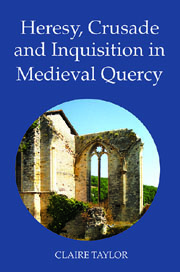Book contents
- Frontmatter
- Contents
- List of illustrations
- Dedication
- Acknowledgements
- Prefatory Note on Words
- List of Abbreviations
- Map 1 Medieval Quercy
- Map 2 Gourdon and its sphere
- The house of Gourdon
- Introduction
- 1 Investigating medieval Quercy: questions about sources
- 2 Medieval Quercy
- 3 War and its aftermath
- 4 ‘Heretical’ Quercy: the evidence gathered by c.1245
- 5 Heresy: a social and cultural life
- 6 Heresy and what it meant
- 7 The reshaping of Quercy
- Conclusion
- Bibliography
- Index
- YORK MEDIEVAL PRESS: PUBLICATIONS
6 - Heresy and what it meant
Published online by Cambridge University Press: 05 February 2013
- Frontmatter
- Contents
- List of illustrations
- Dedication
- Acknowledgements
- Prefatory Note on Words
- List of Abbreviations
- Map 1 Medieval Quercy
- Map 2 Gourdon and its sphere
- The house of Gourdon
- Introduction
- 1 Investigating medieval Quercy: questions about sources
- 2 Medieval Quercy
- 3 War and its aftermath
- 4 ‘Heretical’ Quercy: the evidence gathered by c.1245
- 5 Heresy: a social and cultural life
- 6 Heresy and what it meant
- 7 The reshaping of Quercy
- Conclusion
- Bibliography
- Index
- YORK MEDIEVAL PRESS: PUBLICATIONS
Summary
Deponent Strategies in the Face of Inquisition
It is important to think of inquisition as a diachronic process rather than an institution. Doat manuscripts 21–23 are not evidence of three inquests abstracted from space and time, in no particular order, but are part of an unfolding narrative, each influencing the next. So, when reading the depositions in Doat 21, for example, we must remember that they were made in the knowledge of what had taken place in the inquests of the 1230s. Although the 1230s seem obscurer and dimmer to us, this is only because of the nature of the record. As we have noted, only indirect evidence survives of events such as the mass burning at Moissac, Pons Grimoard's trial, the pre-empting of a trial likely to dispossess the Baussa family at Cahors and so on. These wounds were fresh and surely significant in influencing what people volunteered and concealed from 1241 onwards.
For example, several witnesses were already ‘on thin ice’, most notably the officials Pons Grimoard and Othon de Berètges and the knight Guillaume Guallard, who had been investigated in the 1230s by Guillaume Arnaud and Pierre Seilan. Others claimed that they had previously been absolved for crimes attributed to them by the inquisitors of the 1240s. At Castelnau-Montratier Pétronne de Prestes claimed that although she had sinned she had been absolved by the archdeacon on the orders of the bishop.
- Type
- Chapter
- Information
- Heresy, Crusade and Inquisition in Medieval Quercy , pp. 183 - 208Publisher: Boydell & BrewerPrint publication year: 2011

